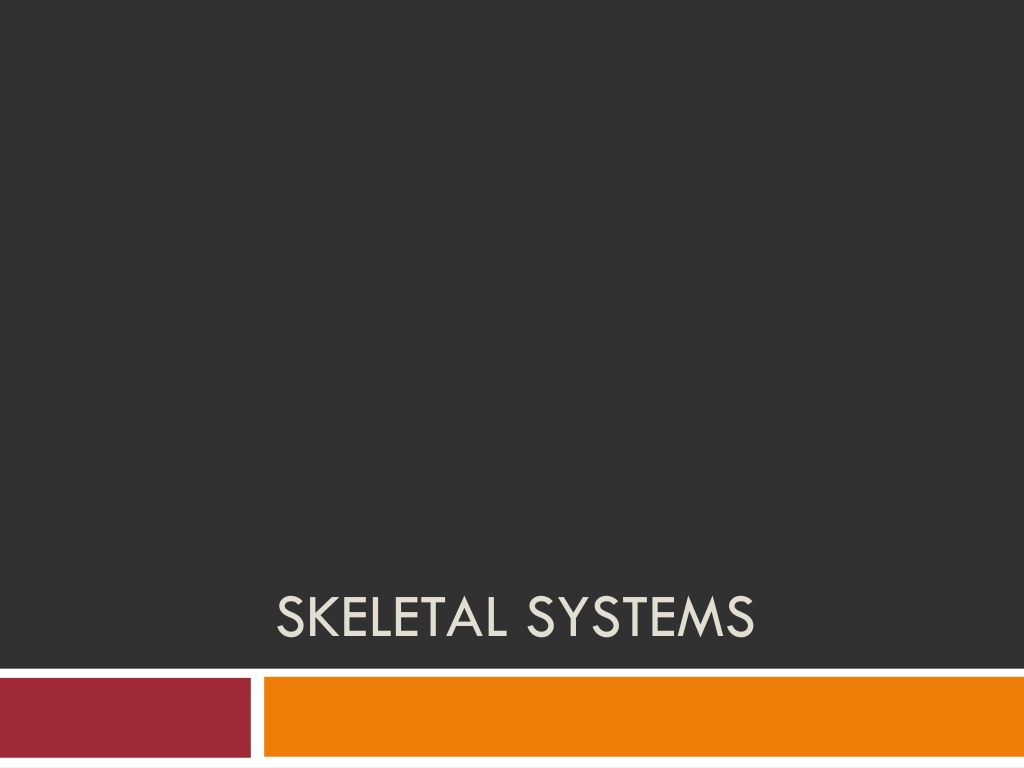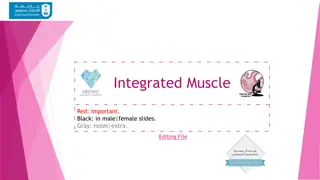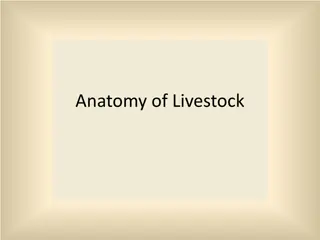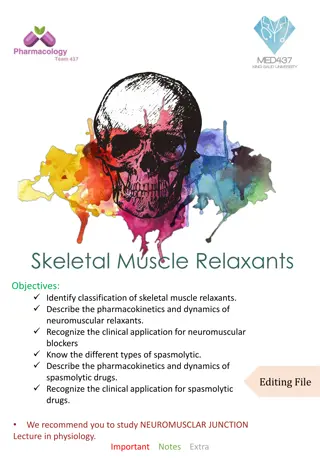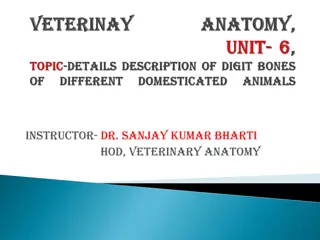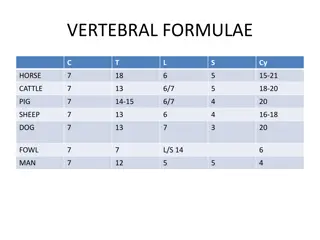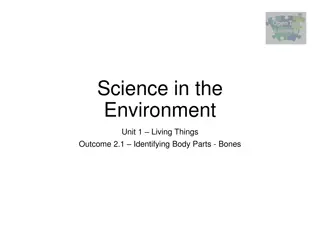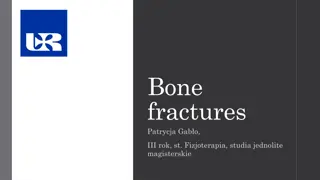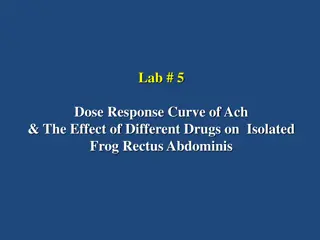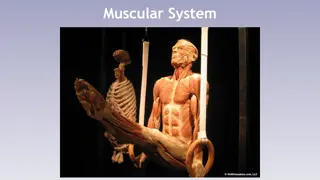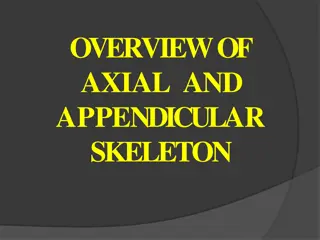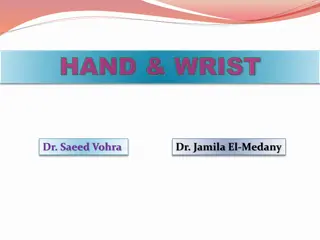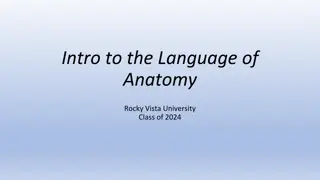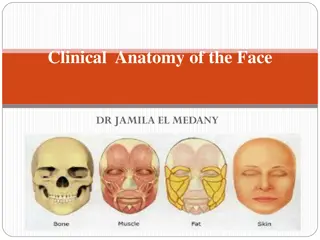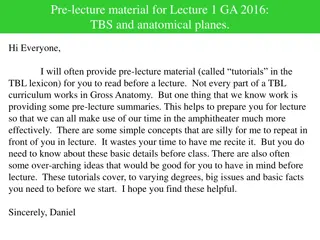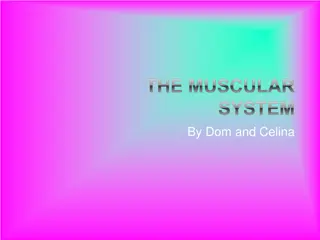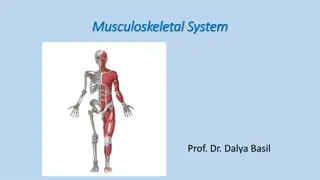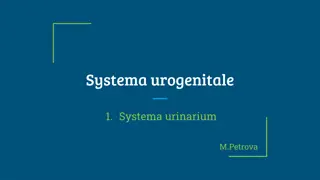Understanding the Anatomy of the Skeletal System
Explore the two major sections of the skeletal system: the Axial Skeleton, which provides protection to vital organs, and the Appendicular Skeleton, enabling movement. Discover variations in bone structure across species, from horses to dogs, and delve into the bones of the Axial Skeleton, including the cranium and vertebral column. Learn about the anatomical divisions of the vertebral column and the functions of cervical and thoracic vertebrae in mammals. Enhance your knowledge of how bones contribute to the structure and function of the body.
Download Presentation

Please find below an Image/Link to download the presentation.
The content on the website is provided AS IS for your information and personal use only. It may not be sold, licensed, or shared on other websites without obtaining consent from the author. Download presentation by click this link. If you encounter any issues during the download, it is possible that the publisher has removed the file from their server.
E N D
Presentation Transcript
Two Major Sections of the Skeleton 2 Axial Skeleton Used to protect fragile tissue that is held underneath Vertebrae, ribs, skull sternum Appendicular Skeleton These bones allow for movement Bones of the limbs 9/22/2024
Variations of Bones 3 Total number of bones vary by species and even within a species Example: Horse 205 bones Dog average - 320 bones Some dogs are born with short tails and others have long tails which change the number of vertebrate present Dewclaws some are born with some are born without changing the number of digits present 9/22/2024
Bones of the Axial Skeleton 4 Cranium Made mostly of flat bones (50 bones in a dog) Shape varies between species and breed Used for protection of the brain and other sense organs (taste, smell, hearing, sight,) Lower jaw mandible, is moveable allowing an animal to obtain and chew food 9/22/2024
Bones of the Axial Skeleton 5 The Vertebral Column Extends the length of the body from the skull Protects the spinal cord and allow for movement Anatomy of the Vertebral Disk Covered with bony arch - protects spinal cord Spinous and transverse process are sites of tendon and ligament attachment Intervertebral disks can be found between vertebrae add cushion between the disks (not found between C1 and C2) 9/22/2024
Bones of the Axial Skeleton 6 The Vertebral Column Broken down into anatomical divisions Cervical (7) Thoratic (13) Lumbar (7) Sacrum (3) Coccygeal (14-23) 9/22/2024
Bones of the Axial Skeleton 7 The Vertebral Column Cervical Vertebrae neck Mammals have 7 Cervical Vertebrae C1 Atlas allows for up and down movement of head C2 Axis allows for side to side movement Thoracic Vertebrae have attached ribs Help to protect the heart and lungs, allow for respiration 9/22/2024
Bones of the Axial Skeleton 8 The Vertebral Column Lumbar Vertebrae lower back between thoracic vertebra and pelvis Flexes and extends as an animal moves Provide support for organs in the abdomen Sacrum Vertebrae Fuse with the pelvis allowing support of the hind end of the animal 9/22/2024
Bones of the Axial Skeleton 9 The Vertebral Column Coccygeal Vertebrae Tail Vary by species and within the species Dogs typically have 20 Coccygeal vertebrae but can range from 6-23! 9/22/2024
Bones of the Axial Skeleton 10 9/22/2024
Create it! 11 Congrats you have graduated from the school of vertebral engineering! Lets put that education to good use! See Handout! 9/22/2024
Bone of the Axial Skeleton Activity 12 Cranial most part first PECTORAL LIMBS Scapula Humerus Radius Ulna Carpus Metacarpal Phlanges 9/22/2024
Bones of the Appendicular Skeleton 13 Scapula Joins the humerus through a shallow ball and socket joint. Flat bone with a spine to attach tendons and ligaments 9/22/2024
Bones of the Appendicular Skeleton 14 Humerus Upper bone of the forelimb. Connects scapula to the elbow 9/22/2024
Bones of the Appendicular Skeleton 15 Radius and Ulna - Forearm Ulna runs to the point of the elbow and accepts the end of the humerus. Radius (cranial) closely connects to the ulna and forms the remainder of the elbow joint. The elbow joint is a hinge joint and the reason that we can twist our forearm is because of the movement between the radius and ulna, not the elbow joint. 9/22/2024
Bones of the Appendicular Skeleton 16 Carpus - Wrist Radius and ulna continue to the carpus. Group of bones arranged in two rows. Number of bones vary among species. Dog 7 Ruminants 6 Horse 7 or 8 9/22/2024
Bones of the Appendicular Skeleton 17 Metacarpus - Hand Long Bones Lots differences in species. Dogs and cats have four long and one much smaller one (dewclaw) Horses have only one major bone, corresponds to the third one in other species, but has two smaller ones as well. Ruminants only have one very large metacarpal bone. As the ruminant embryo develops, the third and fourth one fuse together. 9/22/2024
Bones of the Appendicular Skeleton 18 Phalanges fingers and toes Number of toes corresponds to the number of metacarpal bones. Singular form is phalanx. The last phalanx is covered by the nail or hoof. 9/22/2024
Bones of the Appendicular Skeleton 19 Review the order Scapula Humerus Radius Ulna Carpus Metacarpal Phlanges Create an acronym S H R U C M P 9/22/2024
Bones of the Appendicular Skeleton 20 Caudal End PELVIC LIMBS: Pelvis Femur Tibia Fibula Tarsus Metatarsus Phalanges 9/22/2024
Bones of the Appendicular Skeleton 21 Pelvis 3 fused bones. Pubis Ischium Ilium Sacrum supports the pelvis. Connection can be damaged, and may split away. Pelvis is made of two halves. Each half divides into regions: ilium, ischium, pubis. Ilium joins to the sacrum. 9/22/2024
Pelvis 22 9/22/2024
Bones of the Appendicular Skeleton 23 Femur Leg Bone Ball and socket joint to the pelvis. Goes to the knee. 9/22/2024
Bones of the Appendicular Skeleton 24 Patella Knee Cap 9/22/2024
Bones of the Appendicular Skeleton 25 Tibula and Fibula Similar to Ulna and Radius in forearm 9/22/2024
Bones of the Appendicular Skeleton 26 Tarsus - Ankle 9/22/2024
Bones of the Appendicular Skeleton 27 Metatarsus Top of foot 9/22/2024
Bones of the Appendicular Skeleton 28 Phalanges - Toes 9/22/2024
Bones of the Appendicular Skeleton 29 Review the order Pelvis Femur Patella Tibula Fibula Tarsus Phalanges Create an acronym P F P T F T P 9/22/2024
